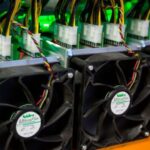CleanSpark, a Bitcoin miner in Las Vegas, is currently building an AI data center alongside its mining operations.
The company continues to operate its Bitcoin business while transitioning to artificial intelligence infrastructure.
The CEO explained the plan on CNBC’s “Crypto World” and said the model is likely to become popular among miners. CleanSpark recently beat Microsoft in a deal, winning a 100-megawatt site in Cheyenne, Wyoming.
The CEO said the deciding factor was speed. CleanSpark built a 100-megawatt mining site in about six months, but building a full AI data center will take three to six years.
“We were able to scale up and install a 100 megawatt Bitcoin mining facility in about six months,” said CEO Matt Schultz. “Indeed, Cheyenne chose CleanSpark because our balance sheet was stronger than Microsoft’s.”
The company used to operate as an energy company, but transitioned into Bitcoin mining five years ago. Schultz said the shift takes the company back to its roots, as competition now revolves around access to electricity.
CleanSpark currently operates 1.03 GW of active facilities and plans to operate 1.7 GW. Schultz describes this model as “megawatt monetization,” using Bitcoin mining to rapidly expand power infrastructure and transform selected locations into high-performance computing for rational AI.
He said Bitcoin miners can quickly build and power data centers, but access to power is the main barrier for everyone in the space.
CleanSpark expands to AI campus
CleanSpark announced a partnership with data center engineering firm Submer to develop AI-focused campuses across North America. The plan combines CleanSpark’s energy and land assets with Submer’s water-cooled high-density systems.
“We are in a position to deliver gigawatts of AI power faster, cleaner and more efficiently than traditional approaches,” Schultz said. He said the goal is to turn CleanSpark’s infrastructure platform into the backbone of the next phase of computing.
One area Schultz pointed to as a growing area for AI clusters is Atlanta, which he said is second only to Northern Virginia on the East Coast in data center development.
Running AI models consumes a lot of power. Companies like Amazon, Google and Microsoft are spending millions on new data centers and signing contracts with power companies to build new nuclear reactors or restart old ones.
Even with that much spending, many new projects face long delays in connecting to the grid. “Hyperscalers are spending 60% of their free cash flow on capital expenditures and trying to catch up with AI,” Schultz said.
He added that miners already control what is most difficult to secure, such as land, substations and direct access to electricity.
Cryptocurrency margins shrink as dual-track model grows
CleanSpark stock is up more than 100% this year. The shift to AI is helping offset the tightening of Bitcoin mining profits after April’s halving cut block rewards in half.
CleanSpark reported third-quarter fiscal 2025 revenue of $198.6 million, an increase of nearly 91% year-over-year, and held 12,703 Bitcoins in its treasury.
Schultz said the AI movement will not replace crypto revenues. “It (Bitcoin mining) is a great part of our business,” he said.
CleanSpark’s power model allows mining operations to be stopped and power returned to the utility company when the grid is stressed, something that cannot be easily done with an AI center.
Schultz said the combination of mining and AI gives utilities flexibility. During Hurricane Helen in Georgia, CleanSpark shut off power and redirected energy. “Within an hour, the hospital lights were back on,” he said.






